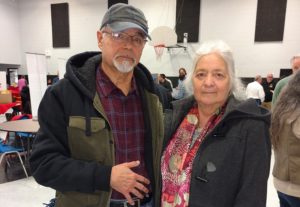Lambton Shores open house brings neighbouring communities together

By Colin Graf
KETTLE & STONY POINT FIRST NATION—Residents and their neighbours from the municipality of Lambton Shores took time last weekend to visit together and find out about activities and projects going on in their side-by-side communities.
Around 70 people attended the Lambton Shores open house held in the gym of Hillside School on Kettle and Stony Point First Nation located on the south shore of Lake Huron. Visitors saw displays and spoke with people involved in projects ranging from conservation to film and theatre presentations, new initiatives in public transit to charting local history.
Visiting the booths gave Debbie Milliken of Kettle Point a “fantastic feeling”. Milliken, a pipe carrier in the First Nation, said it’s important for the two communities to meet each other.
“Our teachings tell us the only way things are going to work out is when the two communities work together. That’s being done more and more,’ she tells the Anishinabek News.
This year’s open house is the third annual event, says Kettle & Stony Chief Tom Bressette. The first time, “only a few” people attended, but the event has grown a lot since then, he says, as visitors stop him for signatures on the cards that qualify them for the draws held during the event.
The event helps build bridges between the communities, he says.
“You let your neighbour know what you’re doing and you get along.”
The event keeps getting bigger and is positive for both communities, says Lambton Shores Mayor Bill Weber.
“This is all about cooperation and supporting each other, and looking for ways we can work together,” he says. One such area is efforts to control the invasive reed phragmites that threatens to choke out native plants and ruin streams and wetlands, Weber says.
Another area is trying to establish public transit in the rural area. Both communities are excited about this possibility, and an application for provincial money for this has just been completed, according to Weber. The regional initiative is asking for $500,000 over 5 years to set up the transit system, with a request for an additional $1.5 million to connect to the larger centres including Goderich, London, and Sarnia.
Encouraging participation in each other’s community events is something else “we can do together”, says Weber. Summer concerts on the Grand Bend beach have featured First Nations performers and Lambton Shores is encouraging their residents to attend the KSP powwow.
“We want people to be aware these things are open to everyone,” Weber explains.
He says the cooperation initiative was sparked at least partly by a dispute over beach access in 2014, when workers from Kettle and Stony Point removed barriers that kept vehicles off local beaches, opening what Chief Bressette has called an historical trail for Kettle and Stony Point. Settling that dispute helped leaders of the neighbouring communities to find out what they can cooperate on, and learning “what needs to change,” Weber explains.
“It made us realize that to not work things out, to not communicate, would be a lose-lose for both communities. Working together, finding a middle ground, moving forward—everybody benefits from that,” Weber tells the Anishinabek News.
“I can text [Chief Bressette] any time and he will text me back,” Weber adds.
For Jamie Colliver, a 24-year Grand Bend resident, the day was “eye-opening.” Colliver said that although he often drives by Kettle Point and the former army camp on the Stony Point lands, the event has shown him he “knows nothing” about the community.
“I could spend two hours here just talking to the First Nations’ community about the struggles they’ve had integrating the two communities [Stony and Kettle]. “We know there have been struggles along the way. We’ve all seen the people living at the [former Camp Ipperwash] base.”
Colliver says there are other important and positive things happening.
“The issues we hear about in the media, but we don’t hear about the development, the school, the beautiful buildings they are going to build here,” he says.
Plans for a heritage centre designed to tell the community’s story, display artifacts, and attract visitors are proceeding, said Kylie Bressette, with Kettle and Stony Point’s Comprehensive Community Plan department.
Plans for the heritage centre, along with a three-storey hotel and conference centre, were announced by Chief Bressette in 2015. First Nations architect Douglas Cardinal, member of the Order of Canada and designer of the national Museum of Civilization in the Ottawa area, has proposed designs for the heritage centre and a new club house at the Kettle and Stony Point-owned golf course.
The Community Plan department has helped put together a “community story” for sharing among members’; has started a yearly Unity Gathering to share teachings and skills around traditional cultural activities; sponsors a local theatre group and storytelling events; and organizes workshops around a range of social issues, says Kylie Bressette.

